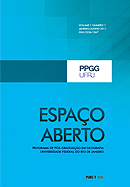Remote Sensing Spatial-Temporal Analysis of Surface Use in the National Park of the Serra da Capivara (Piauí)
DOI:
https://doi.org/10.36403/espacoaberto.2019.23811Keywords:
Caatinga biome, Remote sensing, Conservation.Abstract
In recent decades Brazilian agricultural development has been characterized by the intensive use of natural resources with little or no planning. The Caatinga has become one of the most threatened biomes in Brazil and presents deforested areas which have become pastures. In an attempt to mitigate this deforestation conservation units have the function of protection and conservation of the Brazilian biomes, including the Caatinga. However, even if Brazilian environmental legislation is ambitious its application has been unsatisfactory in many ways. With this in mind, the objective of this article is to offer a spatial and temporal analysis of change in surface use in the Serra da Capivara National Park (Piauí, Brazil) comparing andsat 5 and 8 satellite images from 2006 and 2016. Results show an increase in the area of vegetation of arboreal and shrub types and a reduction in herbaceous vegetation. The area of exposed soil has also decreased, which signals the need for environment preservation in the form of conservation units.Metrics
Metrics Loading ...
Downloads
Additional Files
Published
2019-06-03
How to Cite
PEREIRA, José Antônio Vilar; FULGENCIO DE BRITO, Elielson; SOUZA, Yuri Gomes de. Remote Sensing Spatial-Temporal Analysis of Surface Use in the National Park of the Serra da Capivara (Piauí). Espaço Aberto, Rio de Janeiro, Brasil, v. 9, n. 1, p. 129–142, 2019. DOI: 10.36403/espacoaberto.2019.23811. Disponível em: https://revistas.ufrj.br/index.php/EspacoAberto/article/view/23811. Acesso em: 29 mar. 2025.
Issue
Section
Articles
License
The copyright of articles published in Espaço Aberto belong to their respective authors with rights to first publication conceded to the journal. Every time that the article is cited and reproduced in institutional repositories or personal and professional web pages the link to the journal web page must be provided. The articles are simultaneously licensed under the Creative License Commons BY-NC-SA 4.0.


